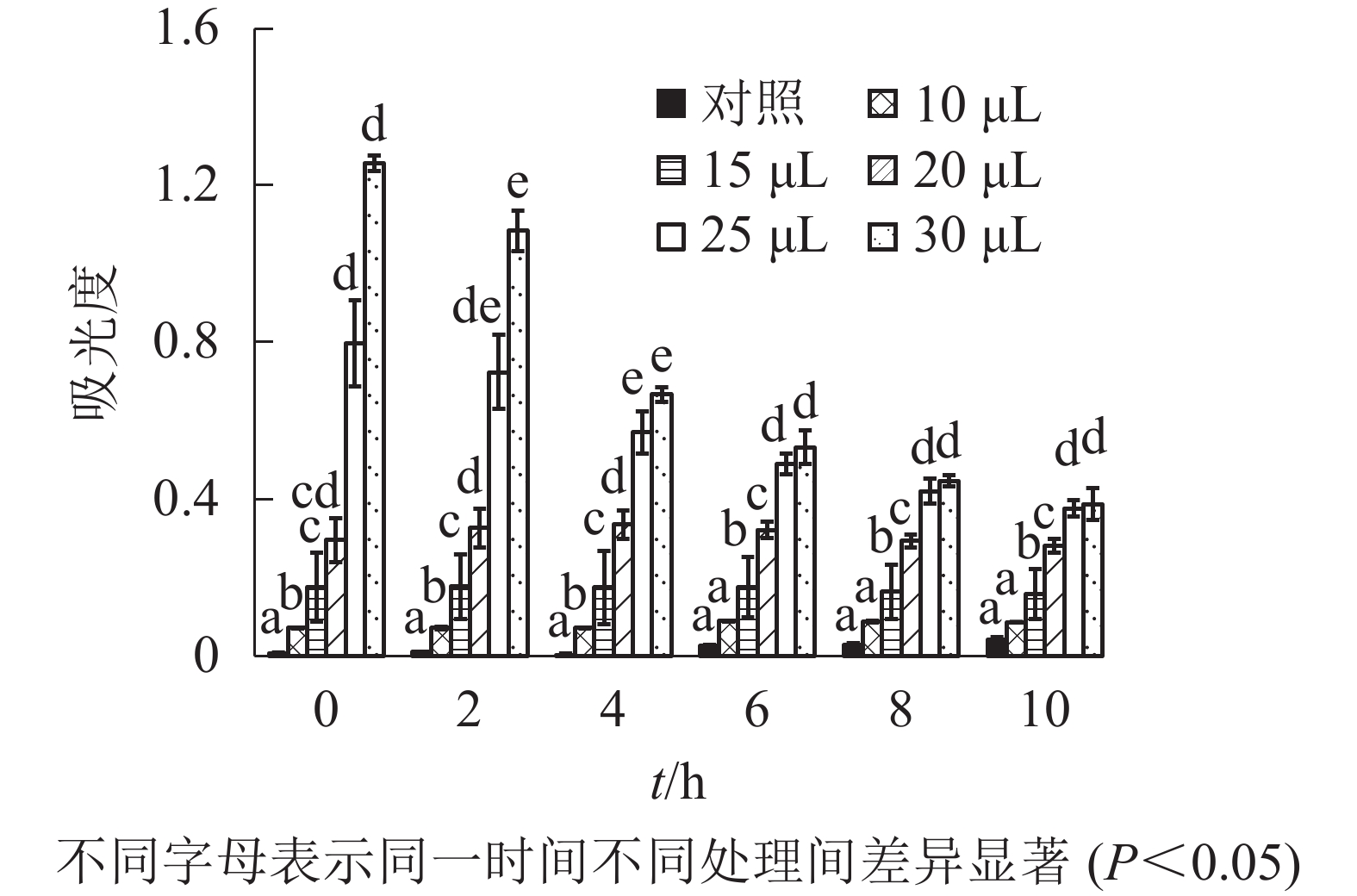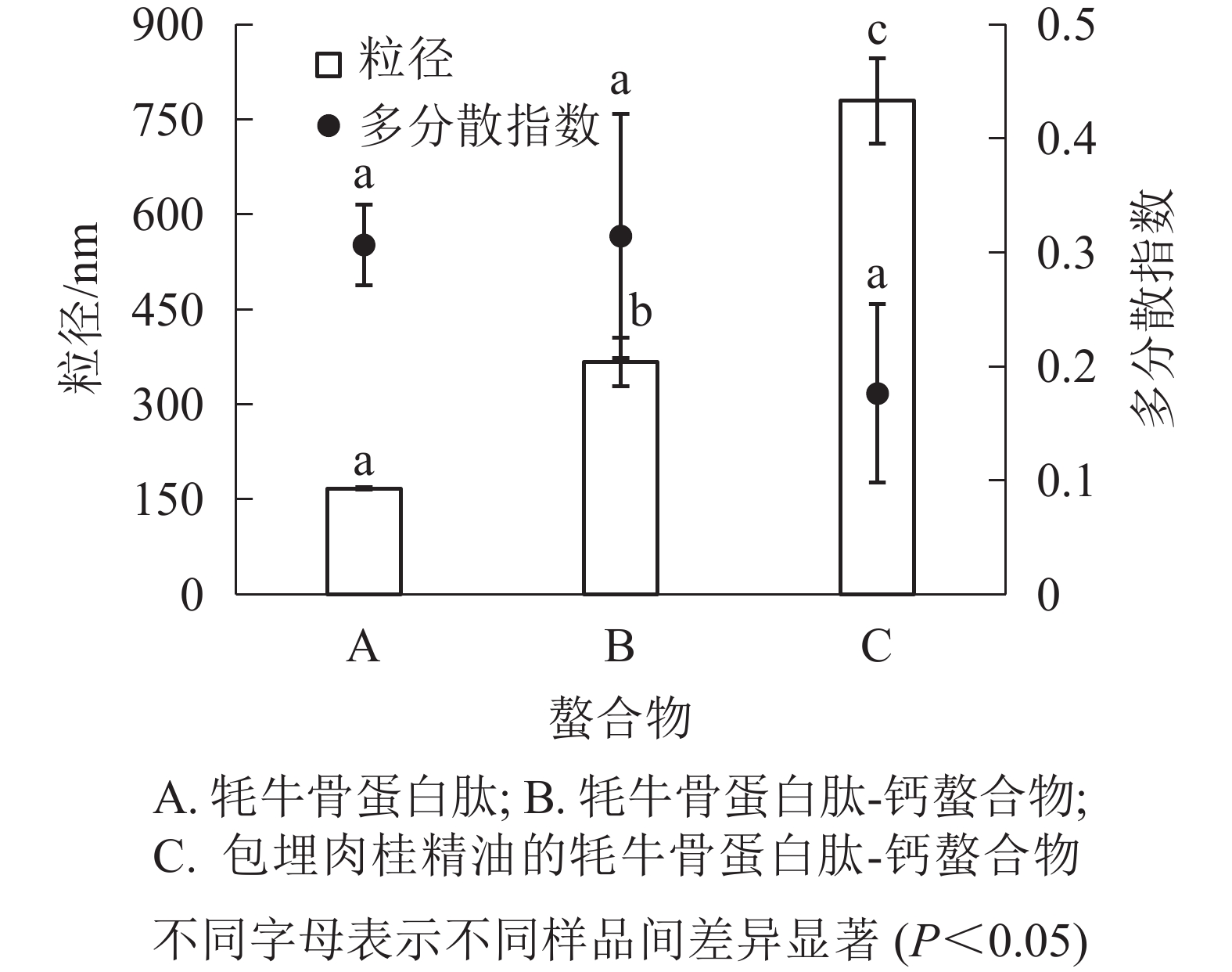-
牦牛Bos grunniens是中国青藏高原及其毗邻高山、亚高山高寒地区的特有珍稀牛种之一[1]。作为牦牛肉加工过程中产生的主要副产物,牦牛骨钙质丰富,是目前市面上优质的小分子骨胶原肽来源[2]。多肽螯合钙是第3代具有活性结构的生物钙补钙制剂,稳定性好,抗干扰能力强,吸收效果好,生物利用度高。甘林火等[3]发现:L-亮氨酸螯合钙的生物利用度比葡萄糖酸钙要高,具有缓释、药效时间长、不需要消耗胃酸等特点。植物来源的精油可以作为调味剂和天然防腐剂,肉桂精油具有清除自由基、抗油脂氧化的作用和较强的抗菌能力[4],是对抗常见食源性病原体的最有效精油之一[5],主要成分为肉桂醛,此外还含有丁子香酚、芳樟醇和α-pine烯等[6]。HUANG等[7]发现:肉桂精油抗菌活性高,能有效抑制微生物生长,延长草鱼Ctenopharyngodon idellus鱼片保质期。OJAGH等[8]发现富含肉桂油的壳聚糖涂层延长了虹鳟鱼Oncorhynchus mykiss冷藏期间的保质期。本研究利用牦牛骨资源,制备包埋肉桂精油的牦牛骨蛋白肽-钙螯合物,探讨其对水产品中的优势腐败菌维氏气单胞菌Aeromonas veronii的缓释抑菌作用,为水产品的防腐保鲜提供新思路。
HTML
-
木瓜蛋白酶购自安琪酵母股份有限公司;维氏气单胞菌由中国农业大学食品科学与营养工程学院水产品加工实验室提供;牦牛骨购自国肽生物科技(北京)有限公司;肉桂精油购自江西恒城天然香料油有限公司。肉桂精油的添加使用遵照GB 2760−2014《食品安全国家标准 食品添加剂使用标准》的相关规定[9]。
-
参考魏洁琼等[10]方法并稍作修改。破碎后的牦牛骨粒经高压灭菌锅蒸煮3.0 h;冷却后除去油脂,过滤得到骨渣和滤液。骨渣∶盐酸(1.0 mmol·L−1)以1∶50(m∶V)酸溶15 h[11],蒸发浓缩,EDTA滴定后用去离子水稀释得到2.0 mmol·L−1的可溶性牦牛骨钙,备用。滤液浓缩,冷冻干燥,得到牦牛骨蛋白;去离子水溶解,调节至60 ℃,pH 7.0[12-13],木瓜蛋白酶(4 000×16.67 nkat·g−1)酶解2.0 h[14],95 ℃水浴灭酶20 min,冷却后离心,取上清液浓缩后冷冻干燥,即为牦牛骨蛋白肽。
-
参照HONG等[15]方法并稍作修改。牦牛骨胶原蛋白肽用去离子水溶解成10.0 g·L−1蛋白肽溶液,离心去除沉淀。在使用均质仪(德国IKA)均质的同时向牦牛骨蛋白肽溶液中逐滴加入牦牛骨钙溶液,得到牦牛骨蛋白肽-钙螯合物。量取10 mL牦牛骨蛋白肽溶液,分别加入0(对照)、10、15、20、25、30 μL肉桂精油,在均质的同时逐滴加入1 mL 0(对照)、0.5、1.0、2.0 mmol·L−1牦牛骨钙溶液,得到包埋肉桂精油的牦牛骨蛋白肽-钙螯合物[16]。
-
参照XIE等[17]方法,通过分子量排阻的高效液相色谱法(SE-HPLC),使用液相色谱仪(日本岛津)测定牦牛骨蛋白肽分子量[18]。仪器参数:TSK凝胶G2000SWXL柱(7.8 mm×300 .0 mm),进样量25.0 μL,流速0.5 mL·min−1,紫外检测器波长214 nm。以三氟乙酸-水-乙腈(体积比为0.1∶54.9∶45.0)为流动相。标准物为细胞色素C(12.362 kDa),抑肽酶(6.5114 kDa),杆菌肽(1.423 kDa),Gly-Gly-Tyr-Arg(四肽,0.451 kDa)和Gly-Gly-Gly(三肽,0.189 kDa)。将混合标准溶液进样,以标准物分子量(M)的对数值为纵坐标,保留时间(t)为横坐标,建立保留时间和分子量对数之间的标准曲线。
-
使用Q-Exactive高分辨质谱仪(美国赛默飞)对样品进行液相色谱串联质谱(LC-MS/MS)全扫描,质荷比为100~1 990 Da[19]。使用Peaks studio 8.0软件结合Mascot MS/MS搜索SwissProt蛋白质数据库,鉴定牦牛骨多肽序列[20]。
-
根据AKBARI等[16]和ZHANG等[21]方法稍作修改,使用可见分光光度计每隔10 min测定1次牦牛骨蛋白肽原始溶液、牦牛骨蛋白肽-钙螯合物和去离子水乳化的牦牛骨蛋白肽(对照)的吸光度(600 nm),计算相对浊度,研究蛋白肽钙螯合物的稳定性。计算公式为:相对浊度=(Ax−A0)/A0×100%。其中:Ax为不同条件下制得的牦牛骨蛋白肽-钙螯合物(或对照)的吸光度,A0为牦牛骨蛋白肽原始溶液的吸光度。
每隔2 h测定1次包埋肉桂精油的牦牛骨蛋白肽-钙螯合物的吸光度(600 nm)[22],以牦牛骨蛋白肽-钙螯合物为对照,研究肉桂精油对螯合物稳定性的影响。
使用ZS90纳米粒径电位分析仪(英国,马尔文)在25 ℃下通过动态光散射(DLS)测定螯合物的平均粒径和多分散指数(PDI)[21]。
-
采用感官评价法和抑菌活性测定缓释效果。取包埋肉桂精油的牦牛骨蛋白肽-钙螯合物和去离子水稀释的等比例肉桂精油样品各1份,室温下静置24 h后,参考朱红梅等[23]进行感官评价。感官指标评分表如表1所示。参照周子雄等[24]的方法并稍作修改测定抑菌活性。活化过夜的维氏气单胞菌菌液[25-26]调整至106 CFU·mL−1,取4份25 mL受试菌菌悬液,分别加入100 μL已灭菌的包埋肉桂精油的牦牛骨蛋白肽-钙螯合物、牦牛骨蛋白肽-钙螯合物、肉桂精油和去离子水(对照),震荡混匀。每隔2 h测定1次菌悬液吸光度(600 nm),检测螯合钙的抑菌效果。抑菌率=(Ac−At)/Ac×100%。其中:Ac为对照组的吸光度,At为不同处理条件下的吸光度。
评分 状态 色泽 香气 异味 协调性 7~9 分散均一,无分层、结块、沉淀 一致,无杂质、霉变 肉桂味浓郁、纯正 气味良好,
无不良风味气味协调 4~6 分散略不均一,无分层、结块、沉淀 不均,有杂质,无霉变 肉桂味较浓郁 稍有异味 气味较协调 1~3 分散不均一,有明显分层、结块、沉淀,
有油滴出现不均,有大量杂质,有霉变 肉桂味不突出 有明显异味 气味不协调 Table 1. Standard of sensory evaluation
-
所有实验重复3次,数据用平均值±标准差表示。采用RStudio 1.3.1073软件对测定结果进行显著性分析,差异显著水平为0.05。
1.1. 材料
1.2. 牦牛骨蛋白肽和可溶性牦牛骨钙的制备
1.3. 包埋肉桂精的牦牛骨蛋白肽-钙螯合物的制备
1.4. 牦牛骨蛋白肽分子量的测定
1.5. 牦牛骨蛋白肽多肽序列的鉴定
1.6. 牦牛骨蛋白肽-钙螯合物的特性表征
1.7. 包埋肉桂精油的牦牛骨蛋白肽-钙螯合物的缓释效果检验
1.8. 数据处理
-
标准曲线方程为:lgM=7.013 8+0.226 9t,计算得到不同分子量区间的蛋白肽占总蛋白的比例。由表2可知:酶解后的牦牛骨蛋白肽肽段的分子量均小于3.0 kDa,其中分子量小于1.0 kDa的牦牛骨蛋白肽占全部肽段的95.867%,说明牦牛骨蛋白肽多为小分子肽。
t/min 分子量/kDa 占比/% <15.579 ≥3.0 0 15.579~<16.363 2.0~<3.0 0.040 16.363~<17.688 1.0~<2.0 4.094 17.688~<18.508 0.5~<1.0 34.211 ≥18.508 <0.5 61.656 Table 2. Molecular weight of yak bone peptides
-
LC-MS/MS测序发现:牦牛骨蛋白肽主要成分为胶原Ⅰ蛋白α1链和α2链,分别含肽段336和285条,肽段覆盖率为55%。共测得945个肽段序列信息,相对分子量为306~1 032 Da,组成肽段的氨基酸为7~37个。对其中分子量小于1.0 kDa且可信度较高的33条蛋白肽段(表3)进一步的分析,牦牛骨蛋白肽可用于制备具备缓释杀菌功能的钙螯合物。
主要肽段 可信度 分子量/Da 质核比 功能 GPVGPVG 40.23 581.317 3 582.324 1 SVPGPMG 32.33 643.299 9 644.306 6 VPGPMGP 31.42 653.320 7 654.326 5 APGPVGPAG 34.80 721.375 9 722.382 3 AP(+15.99)GPVGPAG 31.27 737.370 8 738.377 4 羟基化 FP(+15.99)GADGVA 34.14 748.339 1 749.345 7 羟基化 VP(+15.99)GPMGPS 33.76 756.347 6 757.356 1 羟基化 SDGSVGPVG 36.97 773.355 5 774.362 2 SP(+15.99)GN(+0.98)IGPAG 33.70 785.355 5 786.362 5 羟基化 GAAGPTGPIG 30.08 796.407 9 797.415 6 TPGPQ(+0.98)GIAG 30.34 797.391 9 798.399 9 脱酰胺 LPQPPQE 31.34 807.412 7 808.419 7 IQ(+0.98)GPP(+15.99)GPAG 30.19 809.391 9 810.398 9 脱酰胺,羟基化 AP(+15.99)GPQ(+0.98)GFQ 31.21 817.360 6 818.366 5 羟基化,脱酰胺 GPP(+15.99)GPVGPAG 33.96 820.407 9 821.415 4 羟基化 GP(+15.99)AGPIGPVG 34.90 836.439 1 837.445 6 羟基化 GPVGPTGPVG 37.77 836.439 2 837.445 6 TP(+15.99)GPQGLLG 31.36 854.449 8 855.456 9 羟基化 GASGPP(+15.99)GFVG 31.32 860.402 8 861.412 9 羟基化 GPQ(+0.98)GPVGPVG 31.77 864.434 1 865.440 8 脱酰胺 GIQGPP(+15.99)GPAG 30.73 865.429 3 866.436 9 羟基化 AGPSGPAGPTG 36.13 867.408 6 868.415 5 GPP(+15.99)GLQ(+0.98)GVQ 33.31 868.429 0 869.436 0 羟基化,脱酰胺 GPP(+15.99)GPMGPPG 42.39 878.395 6 879.402 2 羟基化 TGPIGPP(+15.99)GPA 41.22 878.449 8 879.457 6 羟基化 GPP(+15.99)GPIGNVG 33.95 879.445 0 880.452 9 羟基化 GPP(+15.99)GPIGN(+0.98)VG 32.42 880.429 0 881.436 0 羟基化,脱酰胺 GPP(+15.99)GFP(+15.99)GAVG 34.44 886.418 5 887.424 9 羟基化 VGPAGPN(+0.98)GFA 40.33 886.418 5 887.425 0 脱酰胺 AGPP(+15.99)GPTGPAG 31.53 893.424 3 894.431 5 羟基化 AAGPP(+15.99)GPTGPA 34.87 907.439 9 908.446 5 羟基化 VGPAGPN(+0.98)GFAG 38.51 943.439 9 944.445 9 脱酰胺 APGAPGPVGPAG 30.84 946.487 2 947.493 7 Table 3. Identification of partial peptides sequences of yak bone peptides
-
由图1可知:除加入去离子水并乳化的牦牛骨蛋白肽(对照)外,不同浓度牦牛骨钙溶液制成的牦牛骨蛋白肽-钙螯合物的相对浊度存在显著差异(P<0.05)。随牦牛骨钙溶液浓度增加,蛋白肽-钙螯合物相对浊度增加,但不同沉降时间下相对浊度变化不大,说明鳌合效果良好,螯合物稳定,可以用于混合乳液的制备,后续研究选用2.0 mmol·L−1牦牛骨钙溶液制备鳌合物。由图2可知:除牦牛骨蛋白肽-钙螯合物(对照)外,添加不同体积肉桂精油制成的包埋肉桂精油的牦牛骨蛋白肽-钙螯合物的吸光度存在显著差异(P<0.05)。当添加的肉桂精油大于20 μL时,螯合物吸光度随时间急剧下降,稳定性较差;添加的肉桂精油小于20 μL时,螯合物吸光度变化不大,说明稳定性较好。因此后续研究以10 mL牦牛骨蛋白肽中加入20 μL肉桂精油为螯合时肉桂精油的适宜添加量。
-
由图3可知:牦牛骨蛋白肽的粒径为167.8 nm,牦牛骨蛋白肽-钙螯合物的粒径为368.2 nm,包埋肉桂精油的牦牛骨蛋白肽-钙螯合物的粒径为780.2 nm,三者差异显著(P<0.05);牦牛骨蛋白肽、牦牛骨蛋白肽-钙螯合物及包埋肉桂精油的牦牛骨蛋白肽-钙螯合物的多分散指数没有显著性差别(P>0.05),且包埋肉桂精油的螯合物多分散指数小于0.2,螯合物分散性较好。
-
由表4可知:包埋肉桂精油的牦牛骨蛋白肽-钙螯合物的总体评分为7.22分,即该螯合物表观状态良好,分散均一,无分层,色泽一致,无杂质,肉桂香浓郁、风味纯正,气味较协调,无不良气味,其中“香气”项的分值显著高于肉桂精油稀释液(P<0.05)。
感官特性 包埋肉桂精油的牦牛骨
蛋白肽-钙螯合物/分肉桂精油稀释液/分 感官特性 包埋肉桂精油的牦牛骨
蛋白肽-钙螯合物/分肉桂精油稀释液/分 状态 7.60±0.70 b 8.65±0.47 a 异味 7.10±0.99 b 8.00±0.67 a 色泽 8.15±0.34 a 8.25±0.59 a 协调性 6.10±0.88 b 8.15±0.34 a 香气 7.15±1.00 a 4.35±0.82 b 平均 7.22 7.48 说明:不同字母表示样品间差异显著(P<0.05) Table 4. Artificial sensory evaluation results
-
由图4可知:在2 h后,对照和牦牛骨蛋白肽-钙螯合物的吸光度明显上升,维氏气单胞菌大量繁殖;相比之下,牦牛骨蛋白肽-钙螯合物的吸光度值增速更快,12 h抑菌率为−13.70%,推测是牦牛骨蛋白肽为菌的繁殖提供营养。肉桂精油稀释液和包埋肉桂精油的牦牛骨蛋白肽-钙螯合物都表现出了良好的抑菌效果,12 h抑菌率分别为70.24%和77.33%。螯合物对维氏气单胞菌的6 h抑菌率为61.41%,且6 h后抑菌率始终高于肉桂精油稀释液,说明螯合物抑菌效果较为稳定。
2.1. 牦牛骨蛋白肽分子量
2.2. 牦牛骨蛋白肽多肽序列
2.3. 包埋肉桂精油的牦牛骨蛋白肽-钙螯合物的特性表征
2.3.1. 螯合物的相对浊度
2.3.2. 颗粒大小与分散性
2.4. 包埋肉桂精油的牦牛骨蛋白肽-钙螯合物的缓释效果
2.4.1. 感官评价
2.4.2. 抑菌效果
-
人体从外界摄取的蛋白类营养物质被分解后多以小分子肽的形式被吸收利用,肽的螯合能力受分子量影响;相比之下,小分子肽内部活性基团和螯合位点暴露程度较大,与钙离子的接触机率也较大[27]。本研究中得到的多数牦牛骨蛋白肽分子量小于1.0 kDa,属于小分子肽,因此适用于钙螯合物的制备。
本研究发现:大量牦牛骨蛋白肽在pH小于7时带负电荷,有利于蛋白肽侧链与钙离子间的静电吸引,当负电荷被钙离子中和时,中性蛋白肽受到疏水作用影响,形成蛋白肽-钙螯合物。同时,牦牛骨蛋白肽中还存在大量的脯氨酸(P)和甘氨酸(G);HAINES-BUTTERICK等[28]发现:脯氨酸和甘氨酸通常依次出现在β-折叠的边缘链或β-发夹中,这种蛋白质超二级结构有助于形成球形结构[29],可被应用于药物的释放[30]。因此,牦牛骨蛋白肽可用于制备具缓释杀菌功能的钙螯合物。
浊度是评价多肽螯合钙螯合程度的重要指标之一[21],与螯合物粒径正相关;当悬浮液浊度达到原始分散体的50%且随着钙离子浓度增加不再形成沉淀物时,被认为螯合钙形成良好[19]。AKBARI等[16]发现:随着钙离子浓度增加,螯合物的粒径增加。ZHANG等[21]发现:高浓度钙离子可以平衡肽的负电荷,形成沉淀或附聚物(肽-钙螯合物)。本研究中,随着牦牛骨钙溶液浓度增加,相对浊度显著升高,且未生成沉淀物,与AKBARI等[16]结论一致;因此,使用2.0 mmol·L−1牦牛骨钙溶液可形成螯合钙,且稳定性良好。
多分散指数(PDI)可用来表征纳米乳液粒子的分布情况,PDI越小表示乳液粒子分布越均匀[31]。本研究中,通过高速剪切法向牦牛骨蛋白肽溶液中加入牦牛骨钙溶液,粒径明显增加,PDI较小,说明有新的物质形成,即生成了肽-钙螯合物,且分散性较好;继续加入肉桂精油,乳液粒径出现显著增加,推断是形成了包埋肉桂精油的牦牛骨蛋白肽-钙螯合物。
人工感官评定是最基础的食品质量评价方法[32]。本研究制备的包埋肉桂精油的牦牛骨蛋白肽-钙螯合物在各项评价中表现良好,且“香气”项分值显著高于肉桂精油稀释液,与肉桂精油稀释液相比,静置24 h后肉桂香更浓郁,认为螯合物有一定的缓释作用。
微生物是食物腐败的主要原因,抑制微生物生长是延长保质期和提高水产品质量的有效方法,气单胞菌是水产品中的优势腐败菌[33]。本研究中,包埋肉桂精油的牦牛骨蛋白肽-钙螯合物对气单胞菌表现出明显的抑菌效果,与HUANG等[7]结果相符。随时间增长,螯合物抑菌效果逐渐优于肉桂精油稀释液,说明螯合物具有缓释效果,延长了抑菌时间,有助于延长水产品的货架期。
-
本研究利用牦牛骨资源制备包埋肉桂精油的牦牛骨蛋白肽-钙螯合物;通过分析螯合物相对浊度,确定制备条件;通过测定牦牛骨蛋白肽分子量,分析牦牛骨蛋白肽序列,确认牦牛骨蛋白肽适用于螯合物的制备,并推断螯合物形成机制为牦牛骨蛋白肽的负电荷与钙离子间产生静电吸引作用,受疏水作用影响形成球形肽-钙螯合物;通过测定粒径、多分散指数和浊度,表征螯合物特性,确认螯合物的形成;通过测定抑菌率和感官评价实验,验证包埋肉桂精油的牦牛骨蛋白肽-钙螯合物抑菌效果良好,且具有缓释作用,为新型抑菌剂的开发提供思路。







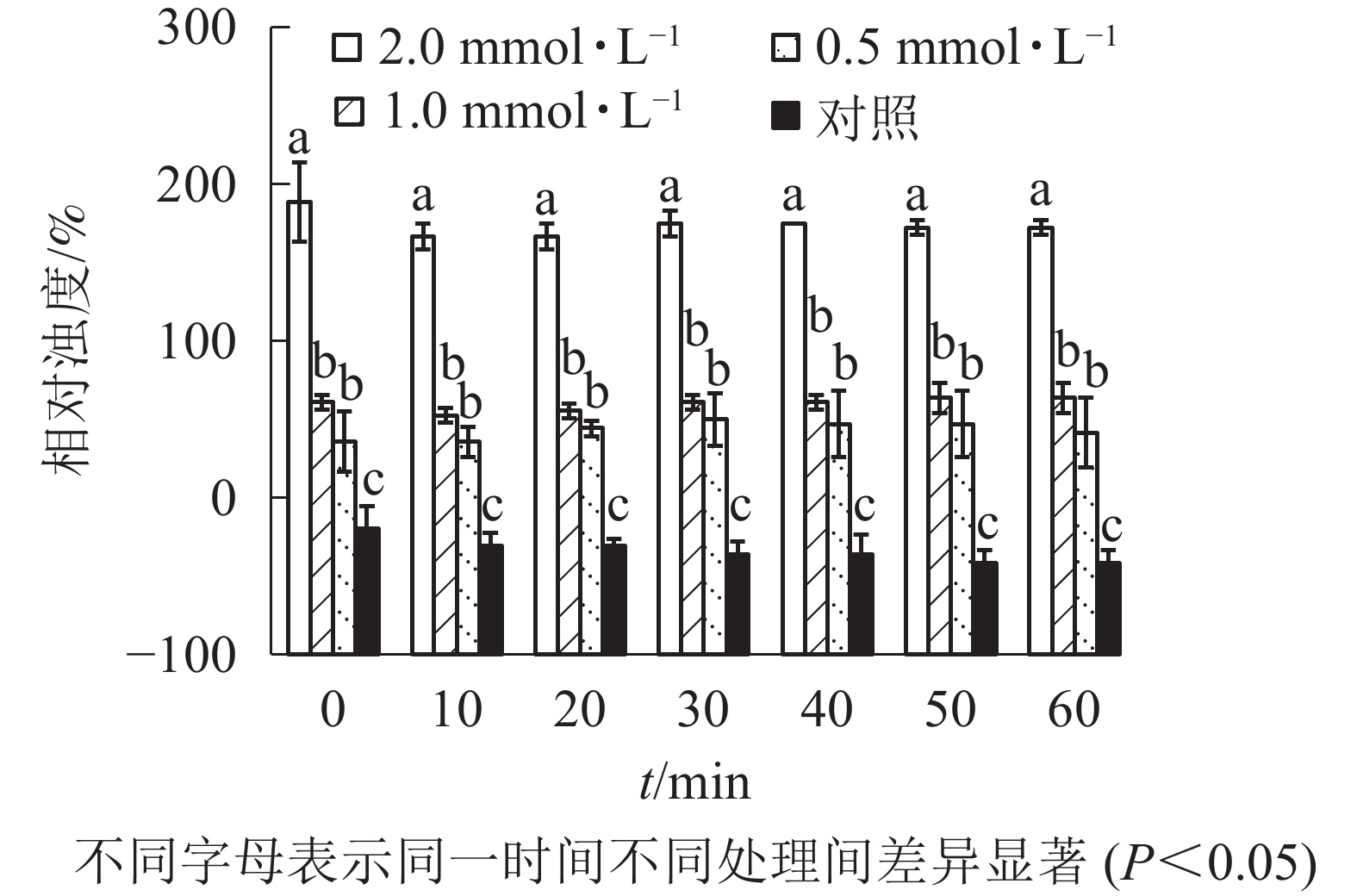


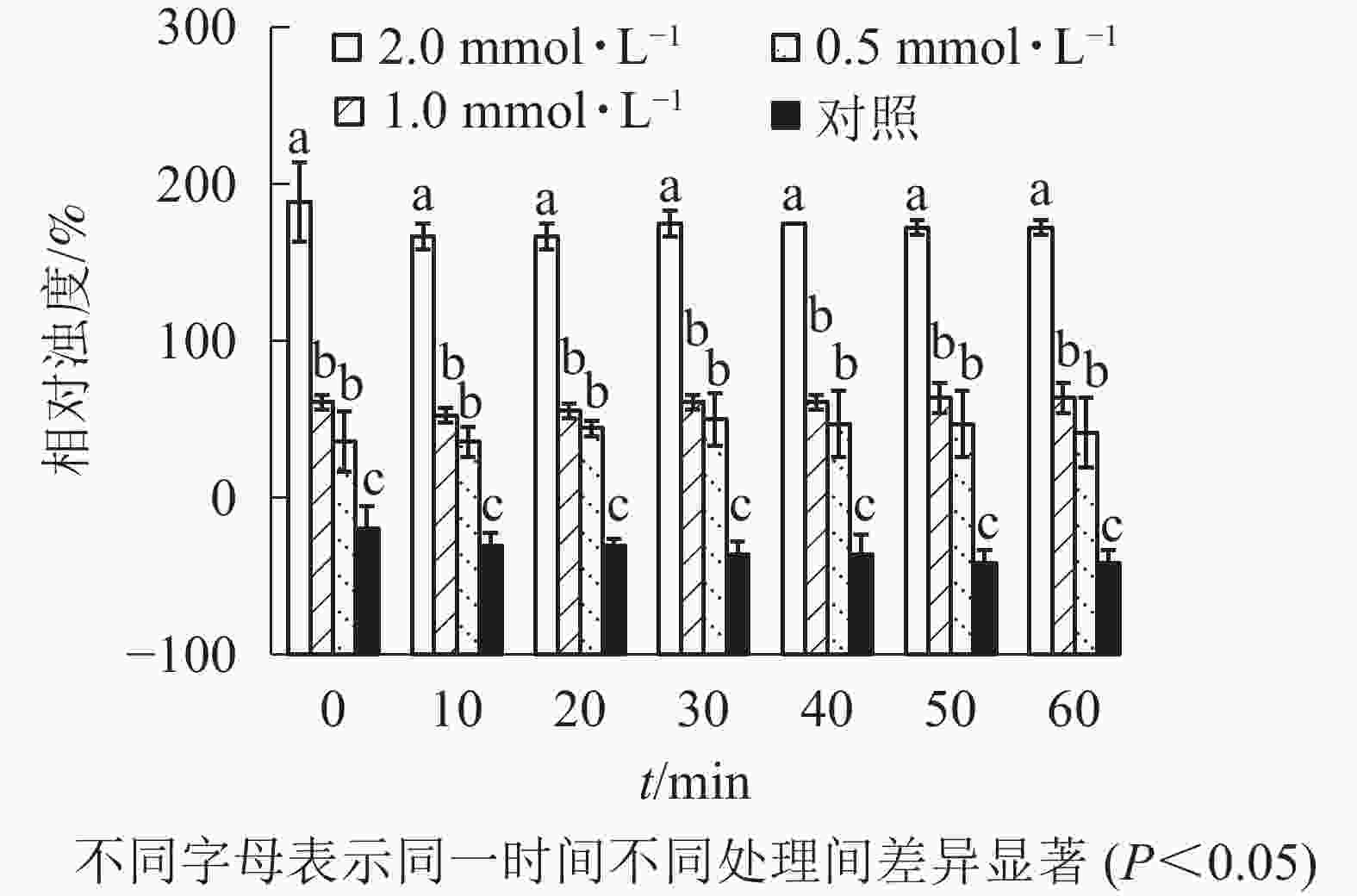
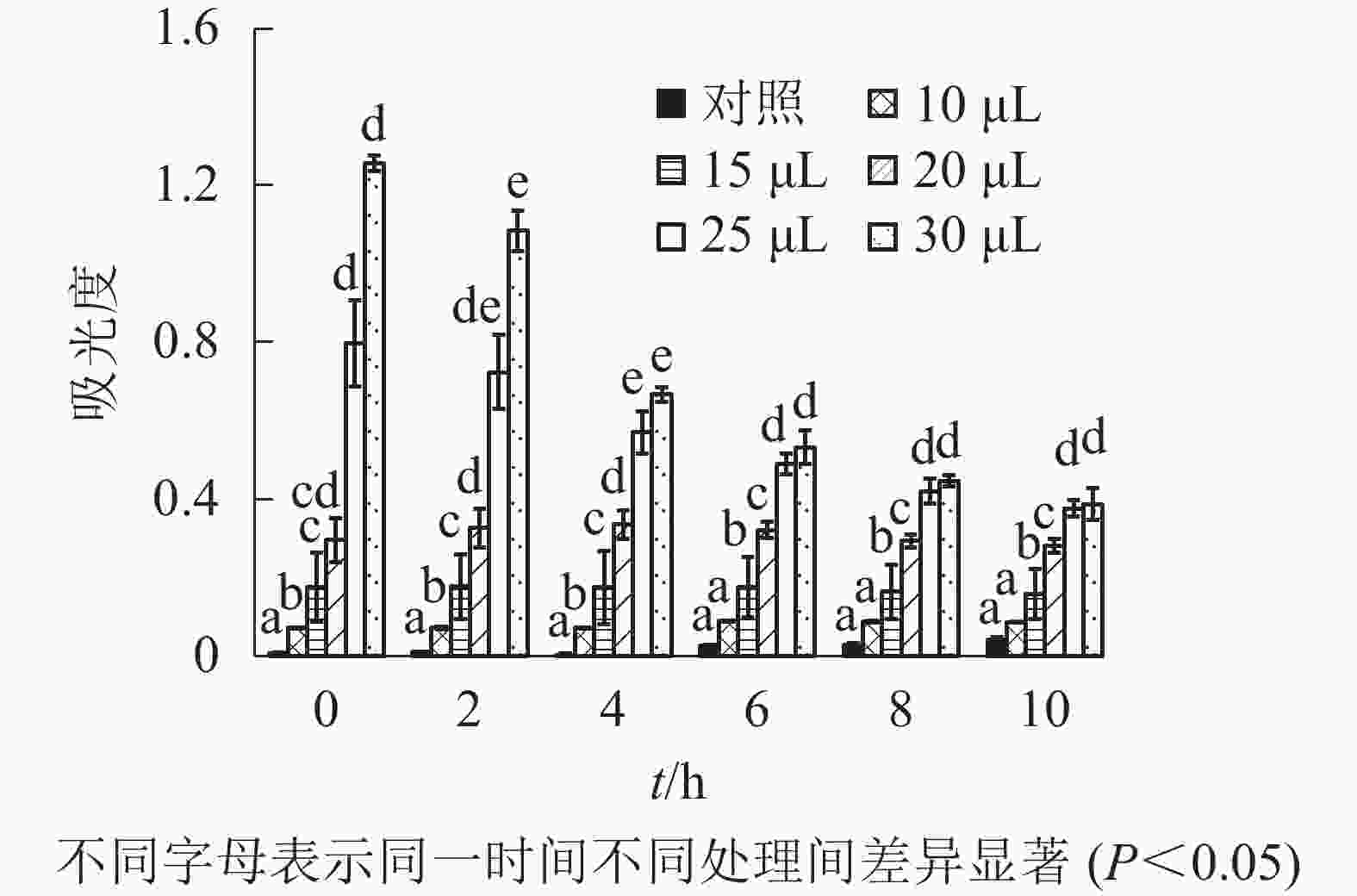
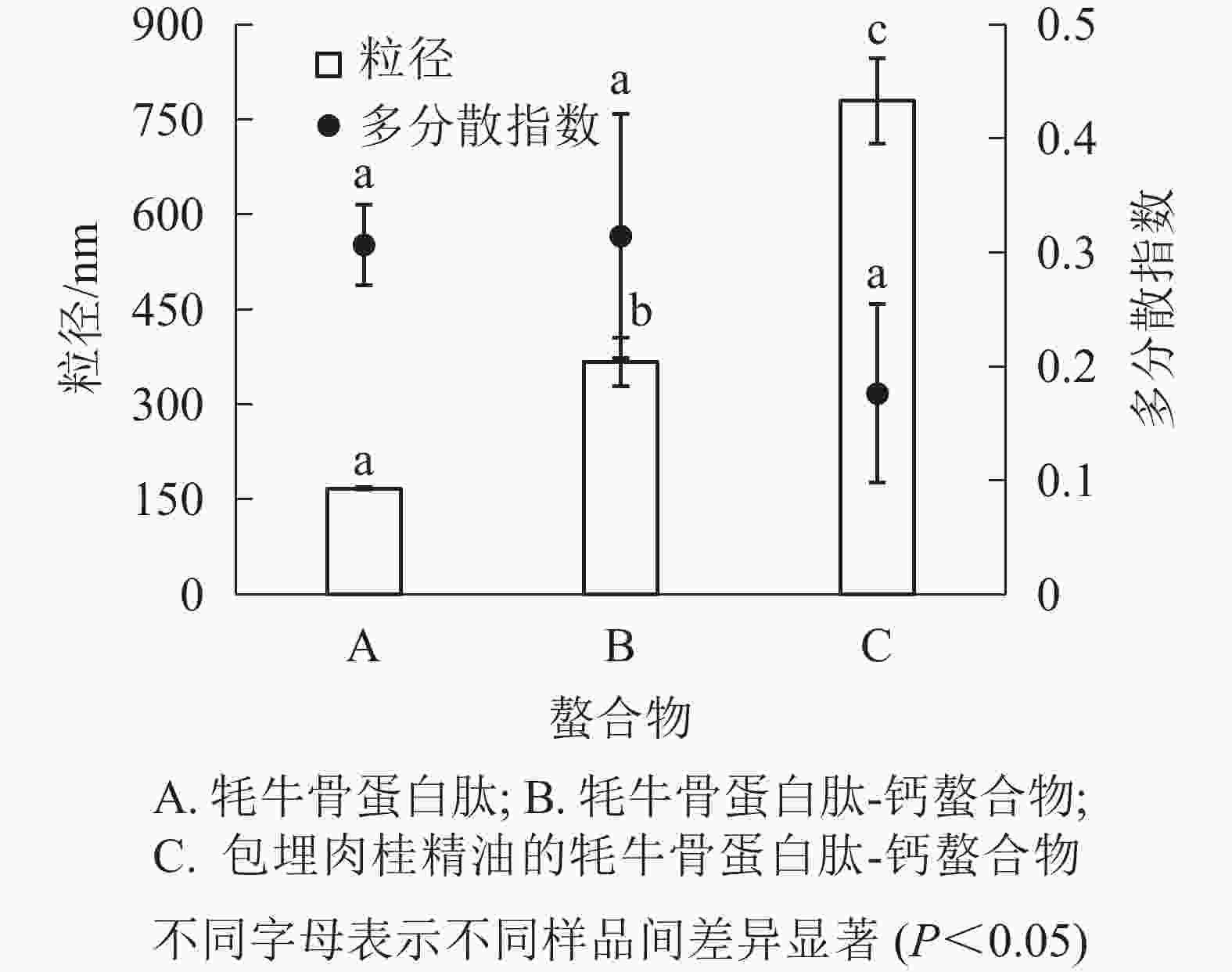
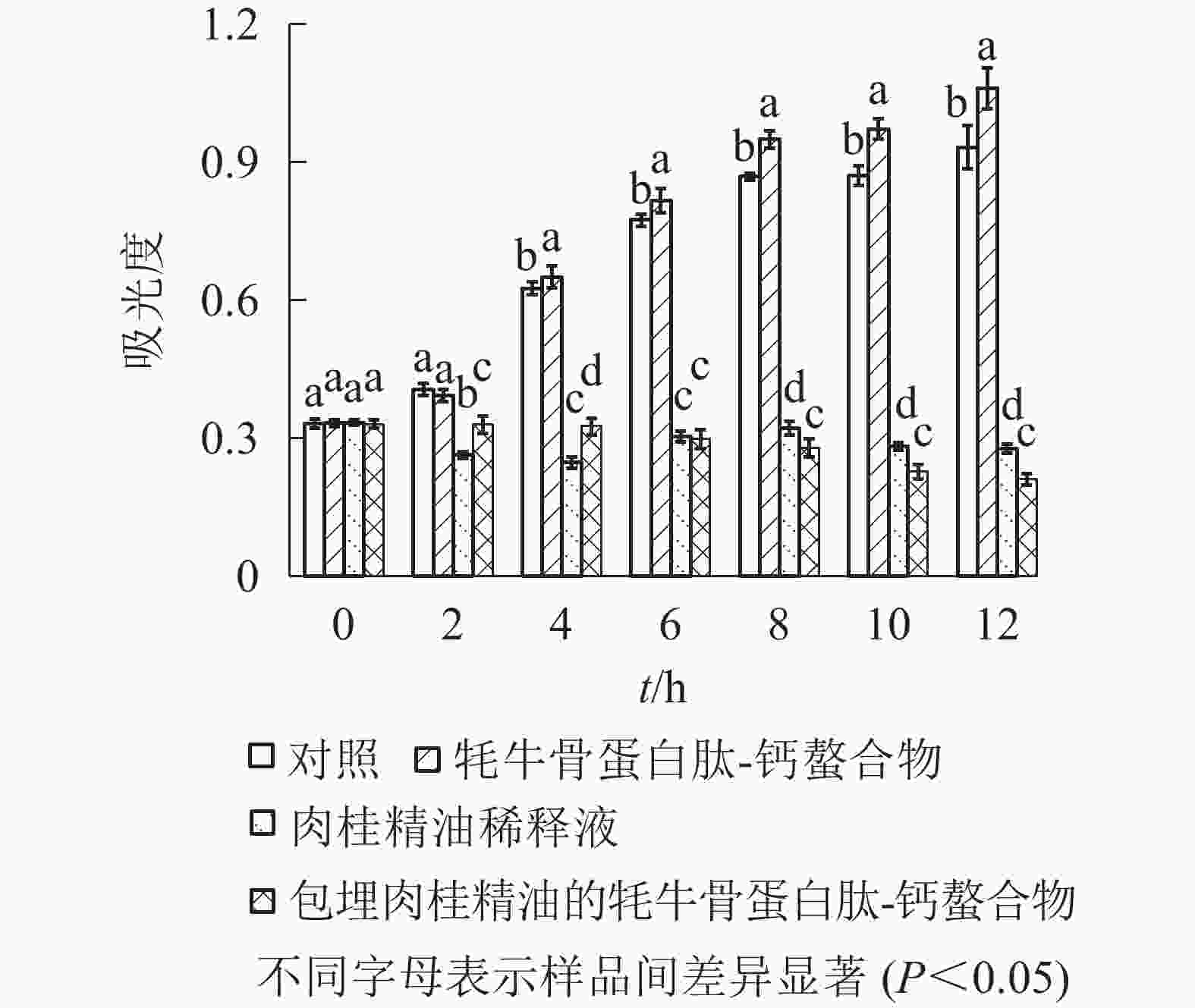
 DownLoad:
DownLoad:
